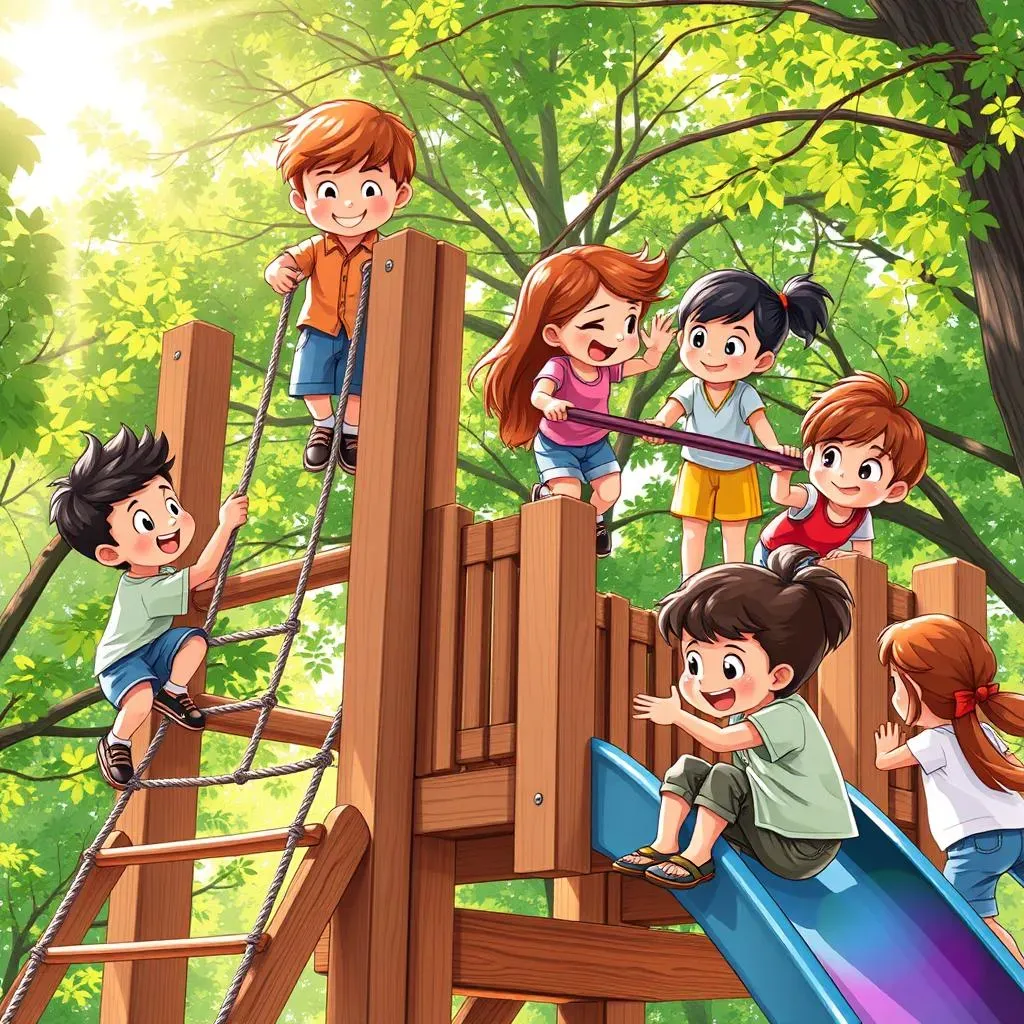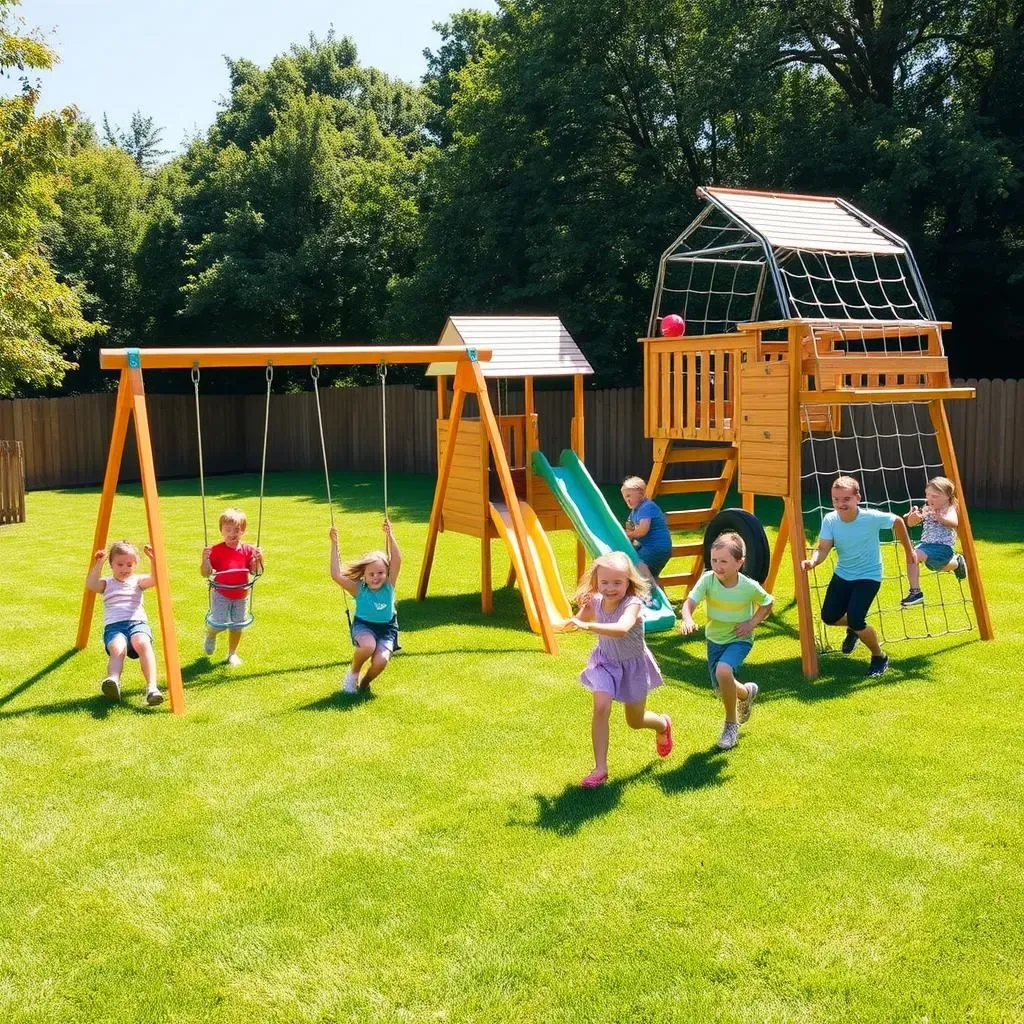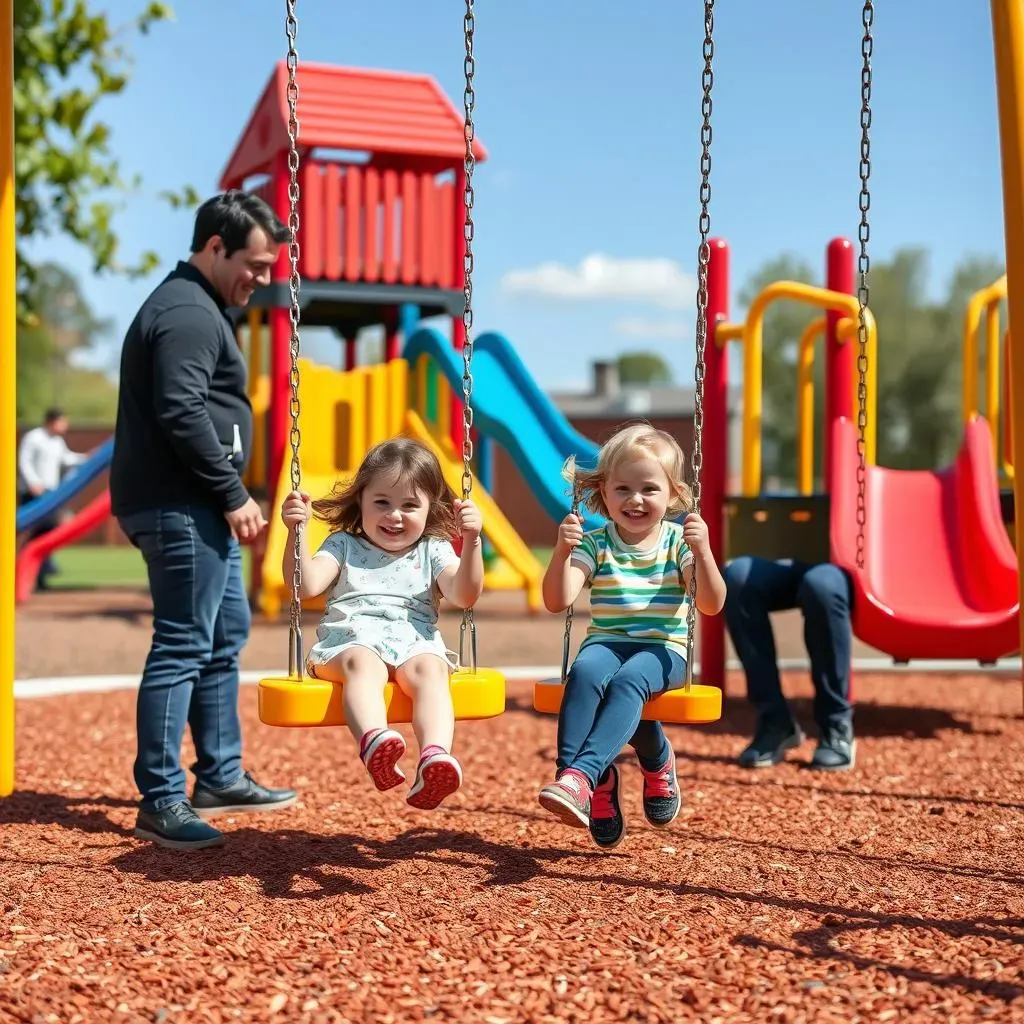Table of Contents
Is your 9 year old bouncing off the walls with energy? Looking for ways to pry them away from screens and into the fresh air? You've landed in the right spot. This isn't just about buying stuff; it's about investing in their development, health, and happiness. Choosing the right outdoor play equipment for 9 year olds can be a game-changer, turning your backyard into an adventure zone. We'll explore why outdoor play is so crucial for this age group, diving into the best types of equipment to get them moving, thinking, and creating memories. From swing sets that reach for the sky to climbing frames that build strength and confidence, we'll cover it all. But it's not just about fun and games; safety is paramount. We'll guide you through choosing equipment that meets safety standards and offer tips for setting up a play area that minimizes risks. So, buckle up and get ready to transform your backyard into the ultimate playground for your 9 year old!
Why Outdoor Play Equipment Matters for 9 Year Olds

Why Outdoor Play Equipment Matters for 9 Year Olds
Seriously, why outdoor play equipment matters for 9 year olds goes way beyond just burning off steam. At this age, kids are developing crucial social skills, problem-solving abilities, and physical coordination. It's a time when structured activities often take over, but unstructured outdoor play allows them to explore their creativity, make their own rules, and learn to navigate social situations without constant adult intervention. Think about it: climbing a tree becomes an exercise in risk assessment and problem-solving, while a game of tag fosters teamwork and communication. Plus, fresh air and sunshine are vital for physical health, boosting vitamin D levels and promoting better sleep. It's about creating well-rounded individuals, not just academically successful ones.
Top Types of Outdoor Play Equipment for Active 9 Year Olds

Top Types of Outdoor Play Equipment for Active 9 Year Olds
Swing Sets: Classic Fun with a Twist
Swing sets are a timeless classic, but today's models offer so much more than just a couple of swings. We're talking about sets with multiple swing types – belt swings, trapeze bars, even tire swings for a bit of pirate-themed fun. Look for sets that include climbing walls, slides, and even built-in playhouses. For a 9 year old, the key is versatility. They need equipment that can keep them engaged and challenged as their interests evolve. Think about adding accessories like a telescope for imaginative play or a small basketball hoop for some friendly competition.
When choosing a swing set, consider the material. Wood sets offer a natural look and can be stained to match your backyard aesthetic, but they require more maintenance. Metal sets are typically more durable and weather-resistant, but can get hot in direct sunlight. Plastic sets are a low-maintenance option, but may not be as sturdy as wood or metal. No matter what material you choose, make sure the set is designed for the weight and age range of your child. Safety is always the top priority!
Swing Set Feature | Benefit for 9 Year Olds |
|---|---|
Climbing Wall | Develops strength, coordination, and problem-solving skills. |
Slide | Provides a fun way to get active and release energy. |
Trapeze Bar | Improves upper body strength and coordination. |
Telescope | Encourages imaginative play and exploration. |
Climbing Frames: Scaling New Heights
For 9 year olds, climbing frames are more than just something to scramble over; they're a challenge, a puzzle, and a source of immense satisfaction when conquered. Forget those basic jungle gyms from your childhood. Today's climbing frames come in all shapes and sizes, from geodesic domes to modular structures that can be customized to fit your space and your child's abilities. Look for frames with varying levels of difficulty to keep them engaged and motivated. Features like cargo nets, rope ladders, and monkey bars add an extra layer of challenge and excitement.
When selecting a climbing frame, think about the long term. Can it be expanded or modified as your child grows? Is it sturdy enough to withstand years of use? And most importantly, does it meet all relevant safety standards? Consider the ground surface underneath the frame as well. A soft landing surface, like wood chips or rubber mulch, can help prevent injuries in case of falls. Encourage your child to explore their limits, but always supervise them closely, especially when they're first getting used to the equipment.
- Geodesic Domes: Offer a unique climbing experience and encourage teamwork.
- Modular Structures: Can be customized to fit your space and your child's abilities.
- Cargo Nets: Provide a challenging and fun way to climb.
- Rope Ladders: Improve coordination and upper body strength.
- Monkey Bars: A classic climbing challenge that builds strength and endurance.
Safety First: Choosing the Right Outdoor Play Equipment

Safety First: Choosing the Right Outdoor Play Equipment
Check the Standards and Certifications
When it comes to safety first: choosing the right outdoor play equipment, don't skimp on research. Look for equipment that meets or exceeds safety standards set by organizations like the American Society for Testing and Materials (ASTM). These certifications ensure that the equipment has been rigorously tested for things like structural integrity, impact resistance, and pinch points. It's not just about trusting the manufacturer's claims; it's about verifying that the equipment has been independently evaluated by experts. Pay close attention to weight limits and age recommendations as well. Exceeding these limits can compromise the safety of the equipment and increase the risk of accidents.
Also, inspect the equipment regularly for signs of wear and tear. Cracks, rust, loose bolts, and splintered wood can all pose hazards. Make it a habit to check the equipment before each use, and address any issues promptly. If you're not comfortable making repairs yourself, hire a qualified professional to do it for you. Remember, a little maintenance can go a long way in preventing accidents and ensuring the longevity of your play equipment.
Consider this: Imagine you're buying a car. You wouldn't just take the salesperson's word for it that it's safe, would you? You'd check its crash test ratings, read reviews, and maybe even have a mechanic inspect it. The same principle applies to outdoor play equipment. Do your homework, ask questions, and don't be afraid to demand proof of safety.
Surface Matters: Creating a Safe Landing Zone
The surface under and around your outdoor play equipment is just as important as the equipment itself. Hard surfaces like concrete or asphalt are a recipe for disaster. Falls are inevitable, and landing on a hard surface can result in serious injuries. Instead, opt for a soft, shock-absorbing surface like wood chips, rubber mulch, or sand. These materials can cushion falls and reduce the risk of head injuries. The Consumer Product Safety Commission (CPSC) recommends a minimum of 12 inches of loose-fill surfacing material for equipment up to 8 feet high.
When choosing a surfacing material, consider factors like cost, maintenance, and accessibility. Wood chips are a relatively inexpensive option, but they decompose over time and require periodic replenishment. Rubber mulch is more expensive, but it's also more durable and requires less maintenance. Sand is a popular choice for sandboxes, but it can be messy and may attract animals. Whatever material you choose, make sure it's properly installed and maintained. Rake it regularly to prevent compaction, and add more material as needed to maintain the recommended depth.
Think of it like this: You wouldn't let your child play on a trampoline without a safety net, would you? A soft landing surface is like a safety net for your outdoor play equipment. It's an essential component of a safe play environment.
Supervision is Key: Never Leave Them Unattended
No matter how safe your outdoor play equipment is, nothing can replace adult supervision. 9 year olds may seem independent, but they still need guidance and supervision to ensure their safety. Stay within sight and sound of your child while they're playing, and be ready to intervene if necessary. Teach them the rules of the playground, and make sure they understand the potential hazards. Encourage them to use the equipment properly, and discourage risky behaviors like climbing on top of slides or swinging too high.
Supervision isn't just about preventing accidents; it's also about fostering positive social interactions. Encourage your child to play cooperatively with others, and intervene if you see signs of bullying or aggression. Use playtime as an opportunity to teach them valuable social skills like sharing, taking turns, and resolving conflicts peacefully. And most importantly, have fun! Get involved in their games, and show them that you enjoy spending time with them outdoors.
Supervision Tip | Benefit for 9 Year Olds |
|---|---|
Stay Within Sight and Sound | Allows for quick intervention in case of accidents. |
Teach Playground Rules | Promotes safe and responsible play. |
Encourage Cooperative Play | Fosters positive social interactions and teamwork. |
Get Involved in Their Games | Strengthens bonds and creates lasting memories. |
Remember, creating a safe outdoor play environment is a team effort. It requires careful planning, responsible purchasing, and vigilant supervision. By following these guidelines, you can help ensure that your 9 year old has a fun and safe outdoor play experience.
Setting Up Your Outdoor Play Area: Tips and Tricks

Setting Up Your Outdoor Play Area: Tips and Tricks
Choosing the Right Location
so you've got the equipment, now where do you put it? Choosing the right location is crucial. You want a spot that's relatively flat, away from potential hazards like fences, sheds, or low-hanging power lines. Think about sun exposure, too. A shady spot is great in the summer, but too much shade can lead to dampness and mold. Ideally, you want a mix of sun and shade throughout the day. Also, consider the proximity to your house. You want to be able to keep an eye on your child while they're playing, so a location that's visible from a window or patio is ideal.
Don't forget to check for underground utilities before you start digging. Call your local utility company to mark any buried lines or pipes. It's a simple step that can prevent a major headache down the road. And finally, think about drainage. You don't want your play area to become a swamp after a heavy rain. Make sure the area is well-drained, or consider adding drainage to prevent water from pooling.
- Flat Surface: Ensures stability and prevents tipping.
- Away from Hazards: Minimizes the risk of collisions and injuries.
- Mix of Sun and Shade: Provides a comfortable play environment.
- Visible from House: Allows for easy supervision.
- Good Drainage: Prevents water from pooling and creating a hazard.
Creating Zones for Different Activities
Creating zones for different activities is like designing a mini-theme park in your backyard. Instead of just throwing all the equipment together, think about how your child will use each piece and create distinct areas for different types of play. For example, you might have a swing set zone, a climbing frame zone, and a sandbox zone. This not only makes the play area more organized, but it also helps to prevent accidents by separating activities that could potentially interfere with each other.
Use landscaping to define the different zones. Plant shrubs or flowers to create natural barriers, or use different types of surfacing materials to delineate the areas. For example, you might use wood chips under the swing set and sand in the sandbox. You can also use fencing or netting to create enclosed areas, especially for activities like ball games. This will help to keep balls from straying into the neighbor's yard or the street.
Play Zone | Equipment | Benefits |
|---|---|---|
Swinging Zone | Swing Set, Tire Swing | Develops coordination, balance, and upper body strength. |
Climbing Zone | Climbing Frame, Rope Ladder | Improves strength, problem-solving skills, and confidence. |
Sand Zone | Sandbox, Sand Toys | Encourages creativity, sensory exploration, and imaginative play. |
Creative Zone | Outdoor Easel, Chalkboard | Foster creative expression and imagination. |
Maintaining Your Play Area
Maintaining your play area is an ongoing process, but it's essential for ensuring the safety and longevity of your equipment. Regularly inspect the equipment for signs of wear and tear, and address any issues promptly. Tighten loose bolts, replace worn-out parts, and repair any damage to the surfacing material. Keep the area clean and free of debris. Remove any sharp objects, such as broken glass or nails, and rake the surfacing material to prevent compaction.
Also, protect the equipment from the elements. Cover it with a tarp during the winter months to prevent damage from snow and ice. Apply a sealant or stain to wooden equipment to protect it from moisture and UV rays. And don't forget to clean the equipment regularly. Wash it with soap and water to remove dirt and grime. This will not only keep it looking good, but it will also help to prevent the spread of germs.
Conclusion: Level Up Their Playtime with the Right Outdoor Gear
So, there you have it – a roadmap to creating an awesome outdoor play space for your 9 year old. Remember, it's not just about buying the flashiest equipment; it's about choosing pieces that encourage activity, spark imagination, and keep them safe. Whether it's a towering swing set, a challenging climbing frame, or a simple sandbox, the right outdoor play equipment can make a world of difference in your child's development. Get out there, explore the options, and transform your backyard into a haven of fun and adventure. Your 9 year old will thank you for it!